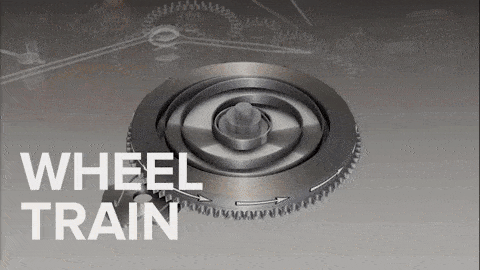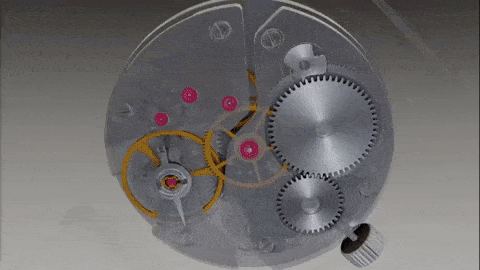Parts of a Mechanical Watch Movement – An Illustrated Guide
Mechanical watch movements are some of the most fascinating and complex machines on earth; packing battery-free time telling capacity into a device that fits on your wrist. While it’s amazing to look inside the intricate mechanisms, have you ever wondered what each piece actually does?
Well, in this quick guide, I’ll be running through each of the main parts of a mechanical watch movement; to give you a basic understanding of how a wristwatch works.
By no means is this a comprehensive list, covering every aspect of every movement out there; each will be slightly different when it comes to components and arrangement. However, this guide will certainly provide you with a solid baseline of fundamental knowledge about the important components.
Core Mechanisms
Crown Assembly – Visible from the exterior, the crown is often the only point of contact between the wearer and the watch movement. The crown typically features a grooved exterior (hence its name), to aid grip. This part is connected to the winding stem and can be pulled out to varying lengths to access different settings; clicking the setting lever into different slots on the setting jumper as it does so.
The crown mechanism is connected to the motion works to enable features such as time adjustment. Most watches also feature a hand-winding capability, allowing the user to rotate the crown (at a set length) to manually tighten the mainspring and provide power to the movement.
Animation credit: youtube.com/Animagraffs
Mainspring – A thin, 20-30cm long strip of hardened metal, coiled to form a spring structure. This metallic spring is contained within the toothed mainspring barrel, to prevent it from unravelling. In the centre sits the winding pinion, attached to a ratchet wheel and click assembly that sit below; which ensure the pinion rotates in one direction, preventing the mainspring from unwinding. Thanks to the ratchet and clicker, all momentum from the mainspring is released via the mainspring barrel.
Animation credit: youtube.com/Animagraffs
Dial train/gear train/wheel train – Positioned next to the mainspring, the wheel train is a series of interlocking gears that drive the timekeeping hands and other wheels within the movement. The centre wheel is driven directly by the mainspring barrel, rotating fully once per hour; powering the minute hand of the watch.
The third wheel adjoins the centre wheel to the fourth wheel, which rotates once per minute; powering the second hand if present. Each gear runs from a central axle featuring a synthetic jewel bearing, to massively reduce friction and wear over time.
Animation credit: youtube.com/Animagraffs
Escapement Mechanism – Positioned at the end of the wheel train and the most delicate part within any watch movement, the escapement assembly controls the flow of power from the mainspring. It ensures that the mainspring doesn’t release all of its power at once.
Force is transferred from the mainspring to the escape wheel from the mainspring via the gear train. The rotation of the escape wheel pushes against the pallet fork, which in turn flicks a section of the balance wheel. The rotation of the balance wheel is kept in check by the hairspring, which contracts to oscillate the wheel back towards the pallet fork.
As the balance wheel returns, it clicks the pallet fork into a second position, releasing the escape wheel for a brief moment before holding it in place once more with the other fork prong. This process restricts the movement of the escape wheel to a very short distance, rather than allowing it (and the other gears) to spin freely. This all happens within a fraction of a second.
The escapement assembly is easily visible in most mechanical wristwatches and is usually the most obvious moving component. Each time the pallet fork switches and locks the escape wheel, it makes a clicking sound; which is audible if you put your ear to the watch. The frequency of this process is also what determines the beat-rate of the watch; indicating how many times the second hand moves per second.
The escapement assembly not only utilises jewels to reduce friction and wear, but also houses a shock absorbent mechanism, to prevent it being thrown out of position if the watch is impacted.
Animation credit: youtube.com/Animagraffs
Motion works – A special set of gears, positioned next to the centre wheel, which help provide necessary functionality. Firstly, these allow the watch hands to be spontaneously rotated for time setting. Additionally, they perform a speed reduction at a ratio of 12:1 for the hour hand; essentially making it run 12x slower than the minute hand, despite both hands occupying the same axle. The gears involved with this speed reduction are the cannon pinion, the minute wheel and hour wheel.
Animation credit: youtube.com/Animagraffs
Individual Parts
Balance wheel – A hollow rotor-like structure that forms part of the escapement assembly (see below). In combination with the hairspring, it oscillates back and forth to help click the pallet fork into the correct place.
Complications – Additional features can be added to a watch to give more information to the wearer; these are known as ‘complications’.
Common complications include:
Subdials
Day/date display
Stop watch (chronograph)
Moon phase
Time zone display
Alarms
Escape wheel – An unusually shaped gear that receives momentum from the mainspring and combines with the balance wheel, hairspring and pallet fork to create the escapement assembly; regulating the timing of the movement.
Hairspring – A small, thin strip of coiled metal attached to the balance wheel. This expands and contracts, allowing the balance wheel to oscillate and return to the pallet fork.
Jewel bearings – Small pieces of synthetic gem, usually ruby, created with corundum and used to reduce friction on key components within a mechanical movement. These also act to increase the lifespan of the bearings, reducing in lower servicing costs over time.
Animation credit: youtube.com/Animagraffs
Oscillating weight/rotor – Automatic wristwatches feature what is known as a ‘rotor’. This is a weight, typically crescent shaped, that sits at the base of the movement and moves freely as the watch is rotated on the wearer’s wrist. The movement of the rotor rotates the central staff, which is attached to the winding mechanism; automatically self-winding the watch, without the need for the user to rotate the crown.
Setting jumper & lever – Two components that combine to form a mechanism that requires the crown to be pulled out before manipulation. This not only allows for multiple functions, but also prevents accidental adjustments to the time. The vast majority of modern wristwatches utilise a lever-set mechanism in this way.
Spring barrel – The mainspring housing, typically featuring a toothed outer, akin to a traditional gear. This barrel will typically pair with a cover, to prevent the mainspring ejecting from its container.
Supporting structure – A variety of specially shaped metal plates that help hold the components of the movement in place. The largest ‘main’ plate acts as a base, while the second-largest plate known as the ‘barrel bridge’ holds the mainspring with its associated components. There are smaller sections, including the ‘wheel bridge’ which supports the wheel train arrangement, the pallet bridge which holds the pallet fork and the balance bridge above, which supports the balance wheel and the remaining regulator assembly.
Animation credit: youtube.com/Animagraffs
Stem/Winding stem – A rod attached to the crown that transfers the crown inputs to the mechanisms within the movement. One end is threaded and cut to size depending on the case dimensions, to fit the crown. The other is square, which interlocks with the winding and setting mechanisms; varying depending on the movement used.
Winding pinion – The winding pinion is a toothed wheel, akin to a gear, that forms part of the mainspring assembly.
Yoke & sliding pinion – Two further components of the crown arrangement, which work together with the setting jumper, to ensure the correct functions are enabled when the crown is extended to a specific length. When the setting jumper is engaged, the spring-loaded yoke moves the sliding pinion to engage with specific gears; notably the motion works.








